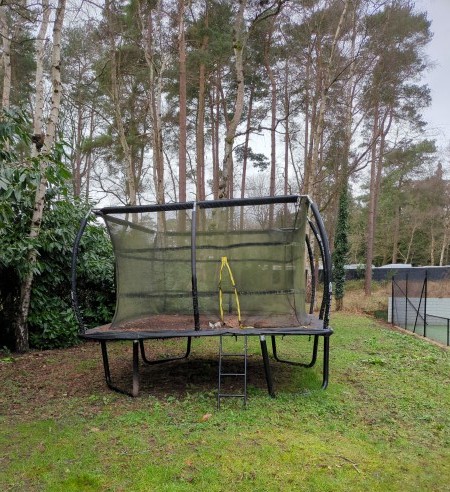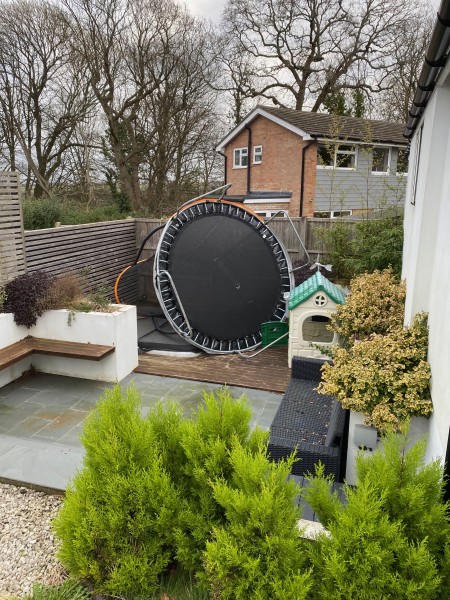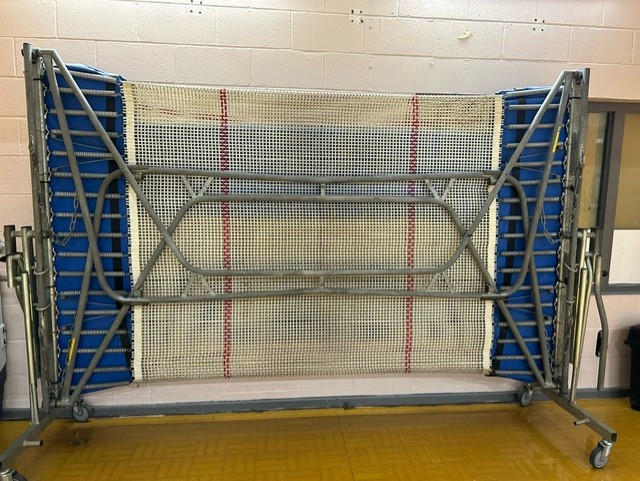Trampoline Dismantling & Removal Service: Comprehensive Guide
 Edited by Ali Lijee
Edited by Ali Lijee
If you’re looking for affordable trampoline removal in the UK, make Rubbish.com your first choice. You’ll surely jump for joy at the competitive prices and quick same-day rubbish removal services offered by our licensed waste carrier member partners operating in towns and cities across the UK.
We dismantle, remove & dispose of trampolines
Table of contents:
- Trampoline dismantling & removal UK
- Trampoline removal service near you
- Gallery of trampolines we have removed
- Trampoline dismantling & removal: questions people commonly ask
Trampoline dismantling & removal UK
Whether you’re de-cluttering your home and need to get rid of a trampoline and other rubbish or your children have outgrown their old trampoline in the garden, you’ll need to find a way to dispose of your unwanted trampoline with minimal effort.
Our rubbish removal partners can disassemble, remove, and dispose of all sorts of trampolines, including round, oval, and square outdoor trampolines, mini trampolines (rebounders), in-ground trampolines, enclosed trampolines, springless trampolines, water trampolines, toddler trampolines, and much more.
Trampoline removal service near you
The rubbish clearance teams listed on Rubbish.com will go leaps and bounds above the competition to bring you great prices on trampoline removal and disposal, including the dismantling of any large trampolines, if required.
Spring into action and get rid of your unwanted trampoline today by choosing a licensed rubbish removal company listed on Rubbish.com.
Gallery of trampolines we have removed
Trampoline dismantling & removal: questions people commonly ask
Will a scrap man take a trampoline?
A scrap man or a rubbish removal company near you can take trampolines as well as all other sorts of garden furniture, children’s toys, BBQs, and much more. Many trampolines have metal frames and components that can be recycled, so most scrap men will gladly accept trampolines.
How do I dispose of a trampoline in the UK?
Some of the most common ways to dispose of a trampoline in the UK include giving it away to a friend, family member, or neighbour, selling it online or through a community group, or having it collected by a man and van rubbish removal company near you.
What kind of metal is a trampoline frame?
Most trampolines designed for residential outdoor use in the UK are made of galvanised steel frames because of the superb durability and strength of steel as well as for being resistant to the elements. Zinc coating is commonly used on galvanised steel trampoline frames to prevent corrosion and rust, although some other alloys may be used depending on the manufacturer.
Will sandbags hold down a trampoline?
Sandbags can be effective at keeping a trampoline secured to the ground and to prevent the trampoline from lifting or blowing away in strong winds. Although sandbags can prevent the trampoline from wobbling or moving under sufficiently strong winds, it is highly recommended that homeowners use stakes or anchors instead to reliably keep the trampoline secured to the ground.
Are trampoline frames steel or aluminium?
Many trampoline frames used in homes in the UK are made of steel, specifically galvanised steel whereby the frame is coated with zinc to prevent rust and to endure the outdoor elements. Steel is generally preferred due to its superb strength, although some manufacturers may opt for aluminium because of its lighter weight and resistance to corrosion. Aluminium is typically used as a trampoline frame material for smaller trampolines.
How many sandbags do I need to hold down a trampoline?
The number of sandbags required to hold down a trampoline can vary depending on anticipated wind conditions in your garden and the size of your trampoline, but generally 1-2 sandbags weighing 25 kg placed on each leg of the trampoline should be sufficient to hold down the trampoline at winds of up to 40 mph.
If possible, consider attaching anchors or stakes instead of using sandbags since these can typically hold down the trampoline much more reliably in windy conditions.
How much wind will lift a trampoline?
Trampolines can be lifted by gale wind speeds of approximately 39-46 mph (Category 8) or higher provided that they are exposed to the wind and are not properly secured to the ground. Trampolines can generally move or wobble from as little as a light to moderate breeze, but will most likely be vulnerable to the wind under a strong breeze or moderate gale wind forces.
How many years should a trampoline last?
A trampoline will generally last for approximately 5-10 years depending on how well it’s cared for, the quality of manufacture, and how frequently it is used. Components of the trampoline tend to have lifespans as follows:
- Mat: 1-5 years
- Frame: 5-10 years
- Springs: 3-5 years
How do I know if my trampoline is safe?
Safety is essential for trampoline use, so always endeavour to inspect the trampoline before use. Specifically, check the trampoline mat for any holes or signs of fraying or wear. If your trampoline has a net or other enclosure, check for signs of wear. For trampolines with springs, ensure that they are in good working condition and that they are attached and secured to the frame and mat.
Do trampolines get more bouncy over time?
No, the opposite is generally the case. Trampolines tend to lose their bounciness with age and frequent use due to the weakened tension of the springs and mat. Significant wear and tear can greatly reduce the bounce of a trampoline, particularly if the springs and/or mat have experienced wear and tear. Replace the mat and springs to restore the full bounce of your trampoline.
Can one person move a trampoline?
Small trampolines can often be moved by one person with relative ease, but larger and heavier trampolines may require two or more people to move. To move a heavier trampoline with an enclosure, it may be safer and easier to first dismantle the enclosure before moving the trampoline.
How long does it take to dismantle a trampoline?
It will generally take anywhere from 30 minutes to a few hours to dismantle a trampoline, depending on the amount of labour and the size of the trampoline. Small trampolines such as personal fitness trampolines and children’s trampolines may take approximately 20-30 minutes for two people to dismantle; large trampolines with enclosures may take approximately 1-2 hours or longer for two people to dismantle.
How do you move a fully assembled trampoline?
To move a fully assembled trampoline, first ensure that you have assistance if the trampoline is large and/or heavy. Round trampolines can be tilted onto the side and rolled (but be careful not to drag) along a tarp or across a smooth surface to the desired location. Square and rectangular trampolines may need to be manually lifted by two or more individuals.
Are trampolines hard to move?
Trampolines can be quite challenging to move from one property to another or in a van due to their typically bulky size and shape. Moving a large trampoline through doorways or into/out of a vehicle may require dismantling the trampoline. One of the most convenient ways to dispose of a bulky trampoline is to retain a private rubbish removal company near you.
What tools do you need to take down a trampoline?
A trampoline can be taken down with various tools, depending on the construction of the trampoline. Tools commonly needed to dismantle a trampoline include a tool for removing trampoline springs, safety gloves and goggles, a stepladder, a screwdriver, wrench, and a rubber mallet.
Also consider placing a tarp or cardboard boxes along the surface where the trampoline components can be sorted and organised as waste.
Can trampolines be left outside?
Most trampolines sold in the UK are designed for outdoor use and are completely safe to leave outdoors and exposed to the elements. The frame and springs of trampolines are typically made of galvanised steel which has zinc coating to prevent rust and corrosion. The safety pad and mat of the trampoline is resistant to UV rays.
Nevertheless, harsh winters and the ebb and flow of the seasons can gradually wear out the tension of the trampoline springs and mat, so care and maintenance are necessary to prolong the lifespan of your trampoline. Be sure to clear out snow from the trampoline’s enclosure and brush it off the mat after a snowfall.
How do you move a trampoline without disassembling it?
There are a few effective methods of moving a trampoline without disassembling it, such as manually lifting it and moving it to a new location, attaching trampoline wheels if your trampoline has them, or tilting the trampoline onto its side and rolling it gently across the garden if it is round.
Moving a trampoline by vehicle without disassembling it can be complex, however. Most passenger vehicles are not capable of safely transporting a full-size trampoline and many vans are likewise too small. Particularly large and bulky trampolines may likely need to be disassembled in order to be transported for waste disposal or to another address.
Should I disassemble my trampoline in winter?
Trampolines can generally sustain the elements in winter in the UK, but it may be wise to partially or fully disassemble the trampoline to reduce wear and tear and also because it is unlikely you’ll be using your trampoline frequently during the winter.
For trampolines with safety enclosures, consider brushing away snow or simply removing the enclosure during the winter.
Do trampolines need to be replaced?
Trampolines tend to require replacement every 5-10 years, on average. The components of a trampoline tend to wear out faster than the frame, however. The trampoline mat may need replacement every 1-5 years, whereas the springs generally require replacement every 3-5 years.
Of course, the question of whether or not to replace your trampoline with a new model largely depends on whether you or your children intend to keep using it.
Is it safe to buy second hand trampoline?
While it may be possible to purchase a second-hand trampoline at a fairly low price, it is seldom worth the cost of transporting the trampoline to your property and used trampolines often have worn out mats, springs, or other components. In general, it is more cost-effective and straightforward to buy a new trampoline rather than buying a used trampoline.

 GET QUOTES
GET QUOTES

